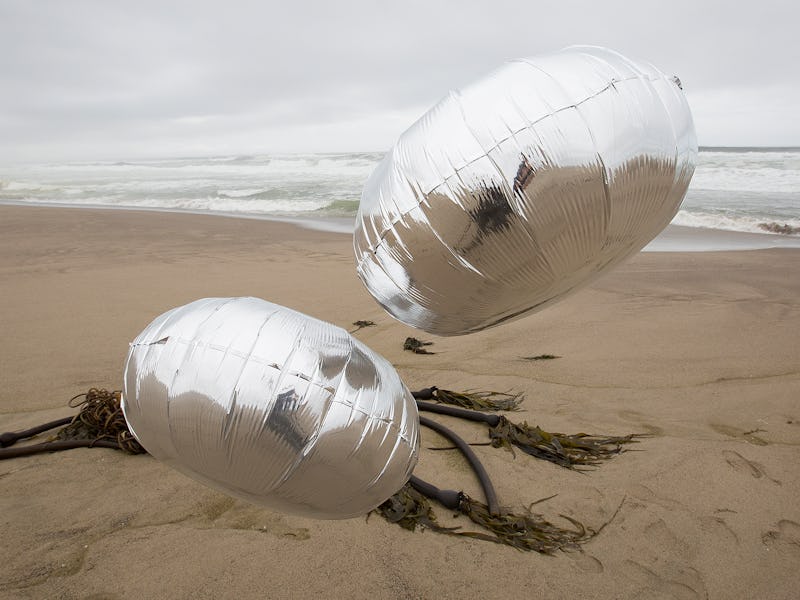Why SETI Scientists Are Putting on an Art Show
It's a collaboration that's both grounded and out-of-this-world.

In May 2010, Charles Lindsay met Jill Tarter, former director of SETI Research and the inspiration behind the film Contact. They instantly became friends and when Tarter invited Lindsay to hang out at the SETI observatory in Northern California he was struck with a thought.
“We’re out under the stars and I said, ‘You know, you’ve got about 70 of the world’s top astro-scientists. Why don’t you have an artist?’” recalls Lindsay.
It might seem like a non-sequitur— How does the search for aliens require art? — but Tarter and Lindsay took their combined talents to heart. Today, the Artist in Residence (AIR) Program at the SETI Institute includes ten artists who work closely with SETI scientists for two years. Designed to integrate art and the science, the goal of the program is to “expand upon the SETI Institute’s mission to explore, understand, and explain the origin, nature, and prevalence of life in the universe.”
It’s first biennial showing premieres at the New Museum, Los Gatos at the end of October and will display work that resulted from the intimate collaboration between scientists and artists. Lindsay compares the relationship to those formed in dating: It’s got to be a mutual, deep connection that is challenging, respectful, fun, and has that special something that is hard to pin down.
The same difficult-to-describe chemistry translates to their work. Here’s an example of one of Lindsay’s projects, “Code Humpback.”
There are no rules in the collaborations between artists and scientists. The idea is not necessarily that the art is supposed to reflect the work being done, or that scientists are supposed to find some frame of artistic reference to expand their search for aliens — though both sides certainly hope that this is the case.
“We don’t want people coming in and saying ‘this is what I want to do,’ like it’s a lock,” says Lindsay. “That’s not interesting. We want people to come in, get access to a kind of people, scientists and facilities, that they wouldn’t have access to otherwise and then see what they come up with. The framework is more so a lattice that allows things to grow.”
A sample-in-progress of one of Kidall's "Strewn Fields" data-etchings.
Scott Kildall joined the program in January 2016 and writes software code that transforms datasets into sculptures, etchings, installations, and physical data-visualizations. His work, “Strewn Fields,” is a result of a collaboration with Peter Jenniskens, a senior research scientist who is a leading expert on meteor showers and meteorite impacts. Kidall has long been fascinated by science fiction and space exploration and jumped at the chance to become involved with SETI.
“The driving force behind my work is uncertainty,” Kidall said. It only makes sense to him that artists work with scientists, “since the institution is working on the cutting edge of space-related research and there is so much that is unknown in this field,” he added.
This eagerness to use art to introduce SETI concepts to an unfamiliar world is echoed in the work of the artist collaborative of Daniel Bazo (one of the roster of creators within the Artist in Residence Program at the SETI Institute), Karl Yerkes, and Marko Peljhan. The trio of artists created an installation, SOMNIUM, combining light, sound, and robotics to conjure an emotional and cognitive reaction to the Kepler mission. They worked with and received data from NASA’s Jon Jenkins, a co-investigator on the Kepler Team, and used real-time sonification of light curves in the installation to represent the numerous stars Jenkins studies.
“Our mission was really to take this stuff that is normally hard science and bring it to life for people who aren’t already excited about it,” says Bazo. “People who aren’t already getting excited about exoplanets — that is our target audience.”
Martin Wilner, an artist and psychiatrist whose work is informed by psychoanalysis, had worked on a project since 2002 that involves choosing a subject, corresponding with them for a month, and then creating drawings every day based on that correspondence. In the end, he has a portrait of that person in relation to the relationship he has built with them, a subjective portrait of that person’s state of mind that month. When approached by Lindsay to join the AIR program, Wilner proposed that he could work with various SETI scientists, see what sort of relationships could develop, and create something that would illustrate that understanding and empathy.
“One of the many missions of the institute is to consider the possibility of an encounter with extraterrestrial life,” says Wilner. “So one of the questions I posed was, if we potentially were to encounter something, how does one communicate with another being of some sort? And within my proposal, part of what I said was that the way we communicate is with language, and language is more than just semantics and syntax — it’s about a relationship. If we are to ever have successful communication [with extraterrestrial beings], then these psychoanalytic issues would be relevant to that kind of encounter.”
Wilner's work "December 2015: Jon Jenkins."
For Mark Showalter, a senior SETI research scientist and a member of the AIR board, the experience has been a privileged one. Himself a photographer who sees a similarity between the way he thinks about a photograph and how he thinks about an image from the Hubble telescope, the program adds a valuable perspective to his work at the Institute: “To be able to see how an artist takes the work we do and make it fresh and interesting in ways that we would never consider doing — to me, that is just one of the great joys of being a part of the program.”